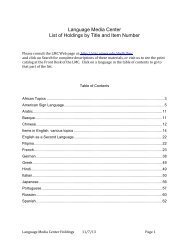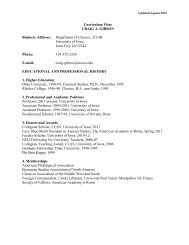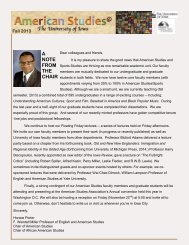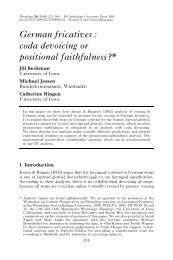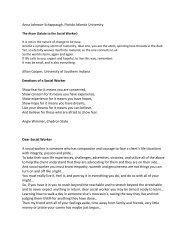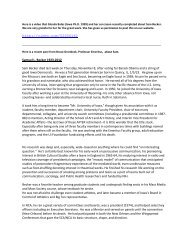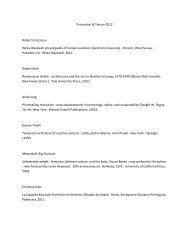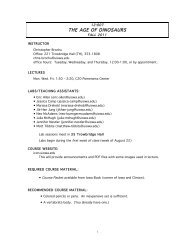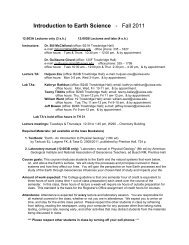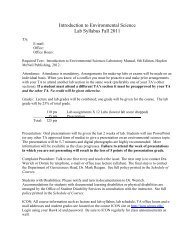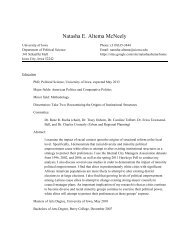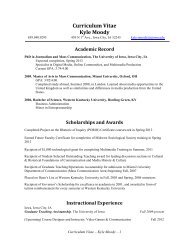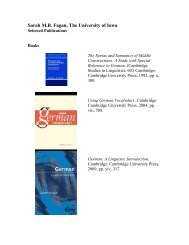Syntactic effects of correlative clause features in Sanskrit and Hindi ...
Syntactic effects of correlative clause features in Sanskrit and Hindi ...
Syntactic effects of correlative clause features in Sanskrit and Hindi ...
Create successful ePaper yourself
Turn your PDF publications into a flip-book with our unique Google optimized e-Paper software.
12-10-06<br />
1. Introduction<br />
CORRELATIVE CLAUSE FEATURES IN SANSKRIT AND HINDI/URDU<br />
Alice Davison, University <strong>of</strong> Iowa<br />
alice-davison@uiowa.edu<br />
Correlative <strong>clause</strong>s represent a parametric variation on relative <strong>clause</strong>s, found <strong>in</strong> various<br />
related <strong>and</strong> unrelated languages (cf. Grosu 2002, den Dikken 2005) In this paper I explore<br />
how this parameter is realized over a period <strong>of</strong> some thous<strong>and</strong>s <strong>of</strong> years <strong>in</strong> Indic languages. I<br />
contrast <strong>correlative</strong> <strong>clause</strong>s related f<strong>in</strong>ite <strong>clause</strong>s <strong>in</strong> the earliest Indic language which is<br />
attested, the <strong>Sanskrit</strong> <strong>of</strong> the Rg Veda <strong>and</strong> early <strong>Sanskrit</strong> prose, with correspond<strong>in</strong>g subord<strong>in</strong>ate<br />
<strong>clause</strong>s <strong>in</strong> a modern Indic language, H<strong>in</strong>di/Urdu. There is remarkable lexical cont<strong>in</strong>uity, <strong>in</strong><br />
that the relative determ<strong>in</strong>ers are formally dist<strong>in</strong>ct from the <strong>in</strong>terrogatives. <strong>Sanskrit</strong> has only<br />
one dependent <strong>clause</strong> type, the <strong>correlative</strong> construction, which corresponds to three k<strong>in</strong>ds <strong>of</strong><br />
subord<strong>in</strong>ate <strong>clause</strong> <strong>in</strong> H<strong>in</strong>di/Urdu: <strong>correlative</strong> <strong>clause</strong>s, complement <strong>clause</strong>s, <strong>and</strong><br />
conditional/adverbial <strong>clause</strong>s.<br />
This comparison allows some exploration <strong>of</strong> how languages divided <strong>in</strong> time share a<br />
specific parameter (Gianollo et al, to appear), <strong>and</strong> to what degree they diverge. The two<br />
language have many common lexical <strong>and</strong> structural properties. But by many syntactic <strong>and</strong><br />
semantic criteria, the <strong>correlative</strong> <strong>clause</strong>s <strong>in</strong> the two languages are sharply different. In Vedic<br />
<strong>Sanskrit</strong>, <strong>correlative</strong> <strong>clause</strong>s are loosely <strong>and</strong> paratactically related to another <strong>clause</strong>, while <strong>in</strong><br />
H<strong>in</strong>di/Urdu, the relation between a <strong>correlative</strong> <strong>clause</strong> <strong>and</strong> the other ‘host’ <strong>clause</strong> is very<br />
closely constra<strong>in</strong>ed, <strong>and</strong> dependent <strong>clause</strong>s are syntactically different from ma<strong>in</strong> <strong>clause</strong>s. I<br />
propose some formal <strong>features</strong> which form l<strong>in</strong>ks between adjo<strong>in</strong>ed <strong>clause</strong>s, <strong>and</strong> guide<br />
semantic <strong>in</strong>terpretation.<br />
This sequence <strong>of</strong> historical changes, which took place at some po<strong>in</strong>t between Vedic<br />
<strong>Sanskrit</strong> <strong>and</strong> the modern languages, <strong>in</strong>volves the grammaticization <strong>of</strong> a semantic predicational<br />
feature, so that what was a default feature becomes a lexical feature <strong>of</strong> relative Ds. The<br />
syntactic relation between the relative <strong>clause</strong> <strong>and</strong> the ma<strong>in</strong> <strong>clause</strong> changes from symmetric<br />
adjunction to asymmetric adjunction. I speculate about what allowed this change; I propose<br />
that it was the change <strong>in</strong> the very old Indo-European clausal projection which allowed an<br />
<strong>in</strong>itial str<strong>in</strong>g <strong>of</strong> particles <strong>and</strong> pronouns. This <strong>clause</strong> structure was reanalyzed as someth<strong>in</strong>g like<br />
the functional projections proposed by Rizzi 1997. These changes opened the way for a<br />
syntactic encod<strong>in</strong>g <strong>of</strong> subord<strong>in</strong>ation, marked by lexically reanalyzed relative D as a functional<br />
head. The direction <strong>of</strong> change proposed here shows remarkable convergence to the syntactic<br />
relations <strong>and</strong> functional categories <strong>of</strong> other modern languages (Roberts <strong>and</strong> Roussou 2003),<br />
whether related or not, while the specific parameter <strong>of</strong> <strong>correlative</strong> structures is reta<strong>in</strong>ed.<br />
2. Introduction to dependent <strong>clause</strong>s <strong>in</strong> <strong>Sanskrit</strong> <strong>and</strong> H<strong>in</strong>di<br />
I beg<strong>in</strong> with a brief overview <strong>of</strong> the end po<strong>in</strong>t <strong>of</strong> change, the syntactically subord<strong>in</strong>ate <strong>clause</strong>s<br />
<strong>in</strong> H<strong>in</strong>di/Urdu. Dependent complement <strong>clause</strong>s are adjo<strong>in</strong>ed to a ma<strong>in</strong> <strong>clause</strong>, <strong>and</strong> are<br />
optionally marked by a complementizer ki (borrowed from Persian) (1). Conditional <strong>clause</strong>s<br />
may be prefixed by a conditional conjunction (2):<br />
1) [H<strong>in</strong>di]<br />
1
ham-nee (yah) puuch-aa [ki kyaa vee aa-eeNgee (yaa nahiiN)]<br />
we ERG this ask-PF that what 3PL come-FUT-PL (or not).<br />
We asked [whether they will come (or not).’<br />
2) [H<strong>in</strong>di]<br />
[agar tum is kuursii-par aisee baiThoogee] ( too) woo Tuut jaeegii<br />
if you this chair-on that-way sit-FUT-2SG then 3SG break go-FUT-3SG<br />
[If you sit that way on this chair] it will break.<br />
H<strong>in</strong>di/Urdu preserves the Indo-European <strong>correlative</strong> construction, marked by a special series<br />
<strong>of</strong> relative determ<strong>in</strong>ers, which are dist<strong>in</strong>ct from <strong>in</strong>terrogatives:<br />
3) [H<strong>in</strong>di]<br />
[joo kitaab(i) maiN-nee kal khariidii] woo(i) khoo gaii hai<br />
rel book I-ERG yesterday buy-PF 3SG be-lost go-pf is<br />
The book(i) [which(i) I bought t(i) yesterday] has gotten lost.<br />
The relative <strong>clause</strong> conta<strong>in</strong>s a relative determ<strong>in</strong>er <strong>and</strong> a common noun. The relative (CP)<br />
<strong>clause</strong> is adjo<strong>in</strong>ed to a ‘ma<strong>in</strong>’ <strong>clause</strong>, a TP conta<strong>in</strong><strong>in</strong>g a correlate phrase, the phrase which is<br />
modified by the relative (see Dayal 1996, McCawley 2004 for fuller <strong>in</strong>formation about this<br />
construction).<br />
This construction is different from the nom<strong>in</strong>ally-adjo<strong>in</strong>ed relative <strong>clause</strong>s <strong>of</strong> modern<br />
European <strong>and</strong> Asian languages (4)-(5). I will beg<strong>in</strong> with a brief schematic <strong>in</strong>troduction to the<br />
<strong>correlative</strong> structure. The nom<strong>in</strong>ally adjo<strong>in</strong>ed structures may have both a restrictive (4) <strong>and</strong> a<br />
non-restrictive <strong>in</strong>terpretation (5). The two k<strong>in</strong>ds <strong>of</strong> relative <strong>clause</strong>s may not have exactly the<br />
same syntactic structure (Safir 1986, Fabb 1990), but both <strong>in</strong>volve some k<strong>in</strong>d <strong>of</strong><br />
subord<strong>in</strong>ation, a relative DP, <strong>and</strong> construal <strong>of</strong> a f<strong>in</strong>ite <strong>clause</strong> which is <strong>in</strong>terpreted as a<br />
predicate modify<strong>in</strong>g a nom<strong>in</strong>al head, roughly (6a).<br />
4) Canonical restrictive relative :<br />
I took the books [which/that/0 you bought ___ yesterday].<br />
(I didn’t take others.)<br />
5) Canonical non-restrictive/appositive relative:<br />
I took the books, [which/*that/*0 you bought ___ yesterday].<br />
(#I didn’t take those you bought today)<br />
6) a. ‘Head’ relative b. Correlative<br />
NP TP<br />
3 3<br />
NP CP CP TP<br />
Correlatives <strong>in</strong> <strong>in</strong>volve a potentially discont<strong>in</strong>uous relation between a relative <strong>clause</strong> <strong>and</strong> a<br />
modified phrase, or correlate, which occurs <strong>in</strong> an adjo<strong>in</strong>ed <strong>clause</strong>. The schematic tree <strong>in</strong> (3b)<br />
represents the structure I propose for <strong>correlative</strong> <strong>clause</strong>s <strong>in</strong> H<strong>in</strong>di/Urdu. If we were to<br />
paraphrase a <strong>clause</strong> like this us<strong>in</strong>g English words but the <strong>correlative</strong> structure, it would be (7).<br />
7) Correlative paraphrase <strong>of</strong> (4)--(6b):<br />
2
[Which books you bought yesterday] I took them<br />
Relative Correlate <strong>in</strong> TP<br />
Relative <strong>clause</strong>s <strong>in</strong> Indic are marked by lexically dist<strong>in</strong>ct determ<strong>in</strong>ers/pronouns, specific<br />
to relative <strong>clause</strong>s. One <strong>of</strong> the strik<strong>in</strong>g <strong>features</strong> <strong>of</strong> both <strong>Sanskrit</strong> <strong>and</strong> H<strong>in</strong>di/Urdu is that it<br />
preserves the Indo-European dist<strong>in</strong>ction between relative, <strong>in</strong>terrogative <strong>and</strong> demonstrative<br />
determ<strong>in</strong>ers (8):<br />
8) Indic relative, <strong>in</strong>terrogative <strong>and</strong> demonstrative series <strong>of</strong> D/DP<br />
<strong>Sanskrit</strong> H<strong>in</strong>di-Urdu<br />
a. Relative yas ‘who-rel.’ joo ‘who, which-rel’<br />
b. Interrogative kas ‘who?’ kaun ‘who?’<br />
c. Demonstrative sas/tat ‘he/that’ yah, woo ‘this/that’<br />
d. Relative yátra ‘where-rel.’ jahaaN ‘where-rel.’<br />
e. Interrogative kva ‘where?’ kahaaN ‘where?’<br />
f. Demontrative tátra ‘there’ yahaaN/wahaaN ‘here/there’<br />
These dist<strong>in</strong>ctions allow us to see quite specifically what the properties <strong>of</strong> a given <strong>clause</strong><br />
constituent may be, <strong>and</strong> consequently to dist<strong>in</strong>guish <strong>clause</strong> types with some certa<strong>in</strong>ty.<br />
3. Clause types <strong>in</strong> <strong>Sanskrit</strong> <strong>and</strong> H<strong>in</strong>di/Urdu<br />
In examples (9a,b,c) I give examples <strong>of</strong> three <strong>clause</strong> types <strong>in</strong> Vedic <strong>Sanskrit</strong>, correspond<strong>in</strong>g<br />
to the modern H<strong>in</strong>di/Urdu structures.<br />
9) Vedic <strong>Sanskrit</strong><br />
a. [Relative]<br />
. [yád îm uœmási kár-tave] karat tát<br />
what-ref he-acc be-eager-pres-1pl do-<strong>in</strong>f do-pres-3s that<br />
RELATIVE CORRELATE<br />
[What(i) we are eager for him to do t], he does that(i)’ (R.V. 10.74.6, Delbrück 1888, p.<br />
b. [Interrogative]<br />
kám âpo ádrim paridhím rujanti [Discont<strong>in</strong>uous D...NP]<br />
<strong>in</strong>t-acc waters-nom cliff wall break-pres-3pl<br />
‘Which cliff as wall do the waters break t? R.V. 4.146d, Etter 1985, p. 73<br />
c. [Dependent <strong>clause</strong>]<br />
[tyâm stoºâma ...] iti tvâ agne . . . ººayah avocan<br />
you-acc praise-fut-1pl quote you-acc Agni-voc sages say-aor-3pl<br />
[We shall praise you...]-quote the sages tell you, Agni.’ R.V. 10.115.8-9 (Hock 1982,<br />
p.49)<br />
10) H<strong>in</strong>di-Urdu<br />
a. [Relative]<br />
[us-nee joo ciiz-eeN tooR-ii haiN] [[un-kii kiimat] [us-kii tankhvaah-see] zyaadaa hai]<br />
3s-erg rel th<strong>in</strong>g-pl break-pf are 3pl-gen price 3s-gen wages-from more is<br />
3
RELATIVE CORRELATE<br />
[Which th<strong>in</strong>gs(i) he has broken t]] their(i) price is more than his salary. Rakesh 161, p. 19<br />
b. [Interrogative]<br />
aap [kisee sab-see acchaa ummiidwaar] samajh-tee haiN?<br />
you who-dat all-than good c<strong>and</strong>idate underst<strong>and</strong>-impf are<br />
‘Who do you consider [who the best c<strong>and</strong>idate]?’<br />
c. [Dependent <strong>clause</strong>]<br />
maiN-nee sooc-aa [ki [raat maarmugaaNw-meeN rah-kar] saweeree feerii-see<br />
I-erg th<strong>in</strong>k-pf that night Marmu-gaoN -<strong>in</strong> stay-prt dawn ferry-with<br />
panjim cal-aa jaa-uuNgaa]<br />
Panjim go-pf go-fut-1sg-m.<br />
‘I thought [that I would spend the night <strong>in</strong> Marmu-Village <strong>and</strong> go on to Panjim by ferry at<br />
dawn.’ Rakesh 1963, p. 32.<br />
Relative <strong>clause</strong>s are marked by the <strong>Sanskrit</strong> y- series <strong>and</strong> its etymological descendant the<br />
H<strong>in</strong>di/Urdu j- series <strong>of</strong> determ<strong>in</strong>ers. Interrogative <strong>clause</strong>s are marked by the <strong>in</strong>terrogative kseries.<br />
<strong>Sanskrit</strong> tends to place these determ<strong>in</strong>ers at the left periphery <strong>of</strong> the <strong>clause</strong>, while<br />
H<strong>in</strong>di/Urdu prefers <strong>in</strong>terrogatives <strong>in</strong> situ, <strong>and</strong> allows relatives to be either <strong>in</strong> situ or at the left<br />
periphery. This difference reflects a difference <strong>in</strong> clausal projections which I will discuss<br />
below. H<strong>in</strong>di/Urdu (1), (10c) has a specialized complementizer ki ‘that’ which marks both<br />
declarative <strong>and</strong> <strong>in</strong>terrogative dependent <strong>clause</strong>s. <strong>Sanskrit</strong> has no lexical mark<strong>in</strong>g specifically<br />
for subord<strong>in</strong>ation; the quotative iti (9c) means ‘thus’ <strong>and</strong> has many other functions unrelated<br />
to <strong>clause</strong> subord<strong>in</strong>ation (Hock 1982).<br />
4. Symmetric <strong>and</strong> asymmetric adjunction <strong>of</strong> <strong>correlative</strong> <strong>clause</strong>s.<br />
It has long been observed that <strong>clause</strong>s <strong>in</strong> <strong>Sanskrit</strong> seem to be l<strong>in</strong>ked <strong>in</strong> a very loose paratactic<br />
way, without syntactic encod<strong>in</strong>g <strong>of</strong> subord<strong>in</strong>ation (for example by Delbrück (1888), Hermann<br />
1895, Gonda 1975, Hettrich 1988). Hock (1989) uses a formal syntactic representation to<br />
express this relation, the symmetric adjunction <strong>of</strong> a full clausal projection to another full<br />
clausal projection, which I express as <strong>in</strong> (11). A <strong>correlative</strong> may precede or follow another<br />
full <strong>clause</strong>.<br />
11) [Symmetric adjunction to another <strong>clause</strong>] (Hock 1989)<br />
. a. CP b. CP<br />
3 3<br />
CP1[Rel] CP2 CP1 CP2[rel]<br />
Relative XP correlate XP.. Correlate XP Relative XP<br />
On the basis <strong>of</strong> systematic comparison <strong>of</strong> <strong>correlative</strong>s <strong>in</strong> <strong>Sanskrit</strong> <strong>and</strong> H<strong>in</strong>di/Urdu below, I<br />
propose an asymmetric adjunction structure for H<strong>in</strong>di/Urdu (9), <strong>in</strong> which the <strong>correlative</strong> CP is<br />
adjo<strong>in</strong>ed to TP, which then is the complement <strong>of</strong> its own CP* projection. This is a base<br />
adjo<strong>in</strong>ed structure (cf. Dayal 1996, McCawley 2004).<br />
12). [Asymmetric adjunction]<br />
4
a. Correlative <strong>clause</strong> b. Right-adjo<strong>in</strong>ed complement <strong>clause</strong>s<br />
CP* CP*<br />
3 3<br />
C’ C’<br />
3 3<br />
C TP* C TP*<br />
3 3<br />
CP[Rel] TP TP CP(i)<br />
3 3 2 3<br />
relative XP(i) correlate. XP(i). yah(i)’this’ C’<br />
2<br />
ki ‘that’ TP<br />
In the next two sections, I will <strong>of</strong>fer evidence for the symmetric/asymmetric adjunction<br />
difference between <strong>Sanskrit</strong> <strong>and</strong> H<strong>in</strong>di/Urdu, <strong>and</strong> propose an account based on formal<br />
syntactic <strong>features</strong> which derives the syntactic differences <strong>and</strong> the range <strong>of</strong> possible<br />
<strong>in</strong>terpretations.<br />
5. <strong>Sanskrit</strong> <strong>correlative</strong>s, H<strong>in</strong>di/Urdu <strong>correlative</strong>s<br />
5.1 Clause architecture- the Clause Initial Str<strong>in</strong>g <strong>and</strong> markers <strong>of</strong> subord<strong>in</strong>ation<br />
A dist<strong>in</strong>ctive prefix to f<strong>in</strong>ite <strong>clause</strong>s is found <strong>in</strong> several very old Indo-European languages,<br />
<strong>in</strong>clud<strong>in</strong>g <strong>Sanskrit</strong> (Hock 1989), Schaüfele (1990) <strong>and</strong> Avestan, Old Persian (Hale 1988).<br />
This is a str<strong>in</strong>g <strong>of</strong> head positions occupied by particles <strong>and</strong> pronouns, which occupy up to five<br />
ordered positions <strong>in</strong> the left periphery <strong>of</strong> the CP (13).<br />
13) Vedic <strong>clause</strong>-<strong>in</strong>itial str<strong>in</strong>g positions ( Hock (1989, p. 115)<br />
Nexus 1 2 3 4 5<br />
conjunction accented unaccented accented enclitic stressed<br />
eg. atha ‘so’ word particle particle pronoun pronom<strong>in</strong>al<br />
[Rel, Int]<br />
Evidence that this <strong>clause</strong> <strong>in</strong>itial str<strong>in</strong>g <strong>in</strong>volves CP projections comes from the nature <strong>of</strong> the<br />
particles, which are sentence oriented.<br />
14) [<strong>Sanskrit</strong>] Sentence-oriented particles:<br />
a. Unaccented: u ‘<strong>and</strong>’ sma ‘always, <strong>in</strong>deed’ ha ‘certa<strong>in</strong>ly’<br />
b. Accented: tú ‘then’ vaí ‘truly, <strong>in</strong>deed’, now, furthermore, surely’<br />
In the str<strong>in</strong>g relative <strong>and</strong> <strong>in</strong>terrogative determ<strong>in</strong>ers may appear as s<strong>in</strong>gle words. They may be<br />
moved from their DP, leav<strong>in</strong>g a remnant NP (Schaüfele (1990). The <strong>clause</strong>-<strong>in</strong>itial str<strong>in</strong>g<br />
seems to be characteristic <strong>of</strong> an <strong>in</strong>dependent <strong>clause</strong>, because it conta<strong>in</strong>s sentence-oriented<br />
particles. Yet the <strong>clause</strong> <strong>in</strong>itial str<strong>in</strong>g is found not just <strong>in</strong> the <strong>in</strong>dependent ‘correlate’ <strong>clause</strong>,<br />
but also <strong>in</strong> the <strong>correlative</strong> <strong>clause</strong> as well (15). The presence <strong>of</strong> the <strong>clause</strong> <strong>in</strong>itial str<strong>in</strong>g <strong>in</strong> both<br />
5
<strong>clause</strong>s <strong>of</strong> (15) is a another <strong>in</strong>dication <strong>of</strong> symmetric adjunction (Hock 1989).<br />
15) [<strong>Sanskrit</strong>] Clause <strong>in</strong>itial str<strong>in</strong>g both adjo<strong>in</strong>ed <strong>clause</strong>s:<br />
[yám(i) u ha evá tát paœávo manuºyéºu yam kâmam(i) árohams]<br />
rel-acc ptcl ptcl ptcl that cattle-pl-nom man-pl-loc rel-acc desire-acc obta<strong>in</strong>-3pl<br />
[tám(i) u ha evá paœúºu tam kâmam(i) rohati]<br />
that-acc ptcl ptcl ptcl cattle-pl-loc that-acc desire-acc obta<strong>in</strong>-pres-3s<br />
‘The desire which(i) the cattle obta<strong>in</strong>ed among men, he obta<strong>in</strong>s the same desire(i) among the<br />
cattle.’(S.B. 2.1.2.7 Hock 1989, p. 12).<br />
D movement <strong>and</strong> the str<strong>in</strong>g <strong>of</strong> particles are completely impossible <strong>in</strong> either ma<strong>in</strong> or dependent<br />
<strong>clause</strong>s <strong>in</strong> H<strong>in</strong>di-Urdu.<br />
5.2 The relative <strong>clause</strong> form for <strong>in</strong>terrogative complements:<br />
The next section <strong>of</strong>fers another example <strong>of</strong> the absence <strong>of</strong> syntactic subord<strong>in</strong>ation <strong>in</strong> <strong>Sanskrit</strong>.<br />
In both languages, that <strong>in</strong>terrogative sentences are marked by the k- series <strong>of</strong> determ<strong>in</strong>ers<br />
(6),(7). Yes/no questions are prefixed by ‘what?’.<br />
16) [<strong>Sanskrit</strong>] Yes/no question<br />
kim aryamòó mahás pathâ- áti kramema dûd.hyo<br />
what? Aryaman-gen great-gen road-<strong>in</strong>st surpass-opt- 1pl <strong>in</strong>ferior-pl-acc<br />
‘Should we overcome the base people on the path <strong>of</strong> the great Aryaman?<br />
(R.V. I. 105.6cd, Etter 1985: 125.)<br />
17) [<strong>Sanskrit</strong>] Constituent question<br />
kó dadarœa [prathamám jâyamânam]?<br />
who? see-perf-3s first-ms-acc born-ms-acc<br />
‘Who has seen [(him) as first born]?’ (R.V. I. 164. 4a, Etter 1985:66.)<br />
If a question is <strong>in</strong> a dependent complement <strong>clause</strong>, Vedic <strong>Sanskrit</strong> substitutes a relative ydeterm<strong>in</strong>er<br />
for the k- <strong>in</strong>terrogative <strong>in</strong> both yes-no questions (18) <strong>and</strong> constituent questions<br />
(19):<br />
18) [<strong>Sanskrit</strong>] Complement yes/no question<br />
ná tásya vidma tád u ºú prá vocata<br />
not this-gen know-pres-1pl this-acc prtl good forth speak-imper-2pl<br />
[yúvâ ha yád yuvatyâh kºéti yóniºu]<br />
youth.m.-nom prt what-rel young.girl-gen lie-pres-3s womb-loc-pl<br />
‘We do not know <strong>of</strong> this, tell us well [whether the young man lies <strong>in</strong> the lap <strong>of</strong> the<br />
young girl.’ (R.V. 40.11ab, Etter 1985, p.210)<br />
19) [<strong>Sanskrit</strong>] Complement constituent question<br />
nâhám tád bhagavan veda [yátra gamiºyãmi]<br />
not I this Lord-voc know-pres-1s where-rel. go-fut-1s<br />
6
‘I do not know, O Lord, [where I will go] (S.B. 14.6.11.1, Hettrich 1989, p.524)<br />
This pattern is found <strong>in</strong> Homeric Greek (Chantra<strong>in</strong>e 1958), <strong>and</strong> disappears <strong>in</strong> both Classical<br />
Greek <strong>and</strong> later <strong>Sanskrit</strong>. Noth<strong>in</strong>g like (18)-(19) is possible <strong>in</strong> H<strong>in</strong>di/Urdu (20).<br />
20) ham-nee (yah) puuch-aa [ki kahaaN/ *jahaaN vee aa-eeNgee]<br />
we -erg this ask-pf that where-<strong>in</strong>t/*where-rel 3pl come-fut-3plm<br />
'We asked [where-<strong>in</strong>t they will come].’<br />
<strong>Sanskrit</strong> has several ways <strong>of</strong> mark<strong>in</strong>g sentential complements: parataxis <strong>of</strong> the selected<br />
complemt <strong>clause</strong>, prefixation or suffixation <strong>of</strong> the quotative iti ‘thus’, or else the <strong>in</strong>terrogative<br />
complement is put <strong>in</strong> relative form, with an <strong>in</strong>terrogative <strong>in</strong>terpretation. The predicate<br />
select<strong>in</strong>g the complement determ<strong>in</strong>es whether it is an embedded question or not (Lahiri<br />
2002). So <strong>Sanskrit</strong> expresses a selection relation, but this selection relation can be expressed<br />
<strong>in</strong> Vedic <strong>Sanskrit</strong> only by the very general CP-CP adjunction licensed by the relative form <strong>of</strong><br />
one <strong>of</strong> the <strong>clause</strong>s. H<strong>in</strong>di/Urdu has an available marker <strong>of</strong> subord<strong>in</strong>ation (ki) which marks<br />
<strong>in</strong>terrogative as well as other complement types as syntactically dist<strong>in</strong>ct from ma<strong>in</strong> <strong>clause</strong>s.<br />
5.3 A conditional <strong>in</strong>terpretation for relative <strong>clause</strong>s without a correlate phrase.<br />
In <strong>Sanskrit</strong>, <strong>correlative</strong> <strong>clause</strong>s without a correlate phrase are not uncommon (Speijer 1896,<br />
Gonda 1975, Hettrich 1988). The relative phrase gets an <strong>in</strong>def<strong>in</strong>ite <strong>in</strong>terpretation, <strong>and</strong> the<br />
whole relative <strong>clause</strong> is translated as a conditional modifier <strong>of</strong> the correlate <strong>clause</strong> (21a).<br />
1<br />
H<strong>in</strong>di/Urdu requires non-relative conditional <strong>clause</strong>s such as (21b).<br />
21) a. [<strong>Sanskrit</strong>] Relative with no correlate, <strong>in</strong>def<strong>in</strong>ite conditional <strong>in</strong>terpretation:<br />
[yó me... yújyo vâ sákhâ vâ<br />
rel-NOM I-DAT ally-NOM or friend-NOM or<br />
svápne bhayám.. .máhyam âha<br />
dream-LOC frightful-ACC word-ACC speak-PRES-3S<br />
stenó vâ yó dípsati ]<br />
thief-NOM or rel-NOM hurt-DESID-PRES-3S<br />
no ... tásmâd varuòa pâhy asmân<br />
we-ACC that-ABL Varuna-VOC protect-IMPER-2S<br />
[If an ally or friend <strong>in</strong> a dream says terrible words to me, or if a thief wishes to<br />
hurt us] protect us, O Varuna, from that. R.V. 2.28.10, Gonda 1975, p. 196.<br />
b. [agar tum is kursii(i)-par aisee baiThoogee, (too) woo(i) Tuut jaaeegii<br />
if you this chair-on so sit-FUT.2SG then 3s break go-FUT.3F<br />
[If you sit that way on this chair(i)] (then) it(i) will break.<br />
Correlative <strong>clause</strong>s require a correlate phrase <strong>in</strong> H<strong>in</strong>di/Urdu. If there is no correlate, the<br />
sentence is ill-formed (22). A nonrestrictive mean<strong>in</strong>g is unavailable.<br />
22) [H<strong>in</strong>di-Urdu] Relative with no correlate<br />
* [jis laRkee-koo anu-nee wahaaN deekh-aa hai] maiN mi<strong>in</strong>aa-see mil ga-ii<br />
7
which girl-dat Anu-erg there see-pf is I M<strong>in</strong>a-with meet go-pf<br />
‘[Which girl Anu has seen there], I met M<strong>in</strong>a. #I met M<strong>in</strong>a, which girl Anu has seen there.<br />
5.4 Correlative <strong>clause</strong>s <strong>and</strong> the appositive <strong>in</strong>terpretation<br />
Correlatives <strong>clause</strong>s <strong>in</strong> the modern languages which have them are typically restrictive, on<br />
the left, <strong>and</strong> typically do not stack (Grosu 2002, Den Dikken 2005). But <strong>Sanskrit</strong> freely allows<br />
<strong>clause</strong>s on the left to modify proper names or pronouns appositively, (23a). The more<br />
expected restrictive modification <strong>of</strong> common nouns, is also possible as <strong>in</strong> the restrictive<br />
<strong>in</strong>terpretation <strong>of</strong> (24).<br />
23) [<strong>Sanskrit</strong> appositive <strong>clause</strong>s]<br />
a. Initial appositive relative <strong>clause</strong><br />
[ yó gºòatâm íd âsitharel-NOM.S<br />
s<strong>in</strong>g-PART-GEN.Pl ptcl be-IMPF-MIDDLE-2S<br />
âpír ûtî œiváh sákhâ ]<br />
ally-NOM favor-INST auspicious-INST familiars<br />
sá tvám ná <strong>in</strong>dra mºïaya<br />
ptcl you-NOM we-DAT Indra-VOC be-gracious-CAUS-IMPER-2S<br />
O Indra, who has become the good friend <strong>of</strong> the S<strong>in</strong>gers with your favor to your<br />
familiars, be merciful to us, (RV 6.45.17, Hettrich 1988, p. 639.)<br />
b. F<strong>in</strong>al appositive relative <strong>clause</strong><br />
agním stuhi daivavâ tam devaœravo<br />
Agni-ACC praise-IMPER-2S daivevata-ADJ. Devashravas-VOC<br />
yó jánânâm ásad vaœí<br />
rel-NOM people-GEN.PL. atta<strong>in</strong>-SUBJ-3S subjection-ACC<br />
Praise Agni(i) the one <strong>of</strong> Devavata, o Devashravas, who(i) should atta<strong>in</strong> the<br />
subjection <strong>of</strong> the peoples. (RV 3.23.3c, Hettrich 1988, p. 632.)<br />
24) nâhám tám veda [yá íti brávîty]<br />
not-I-NOM that-ACC.MS know-PRES.1S rel-NOM.MS thus speak-PRES-3S<br />
[Restrictive]I do not know [the one [who speaks thus]].<br />
[Interrogative] I do not know [who speaks thus. (R.V. 10.27.3a Hettrich 1988, p. 523)<br />
H<strong>in</strong>di/Urdu does not allow appositive <strong>correlative</strong>s, (21), <strong>and</strong> <strong>in</strong> (25a). The appositive read<strong>in</strong>g<br />
is allowed typically <strong>in</strong> relative <strong>clause</strong>s adjo<strong>in</strong>ed to the right <strong>of</strong> DP (25c). a construction which<br />
Hock (1989) argues persuasively is not found <strong>in</strong> <strong>Sanskrit</strong>.<br />
25) [H<strong>in</strong>di/Urdu]<br />
a. *[joo(i) khaRii hai] anu(i) lambii hai<br />
rel st<strong>and</strong><strong>in</strong>g is Anu tall is<br />
‘Anu, who is st<strong>and</strong><strong>in</strong>g, is tall.’ Dayal 1996, p. 155<br />
b. (*)anu(i) lambii hai [joo(i) khaRii hai]<br />
Anu tall.F is rel st<strong>and</strong><strong>in</strong>g-F is<br />
‘Anu, who is st<strong>and</strong><strong>in</strong>g, is tall.’ (Ibid)<br />
8
c. anu(i) [joo(i) khaRii hai] lambii hai.<br />
Anu rel st<strong>and</strong><strong>in</strong>g-F is tall-F is<br />
‘Anu, who is st<strong>and</strong><strong>in</strong>g, is tall. (Ibid)<br />
5.5. Stacked relative <strong>clause</strong>s<br />
<strong>Sanskrit</strong> allows stacked <strong>correlative</strong>s, both to the left <strong>and</strong> to the right <strong>of</strong> the <strong>in</strong>dependent<br />
<strong>clause</strong> (26).<br />
26) [<strong>Sanskrit</strong>] Stacked relatives on the left: yas(i) yas(i) ... sa(i) with verb gapp<strong>in</strong>g:<br />
a. [yah(i) sûryam yah(i) uºásam jajâna<br />
rel-NOM sun-ACC rel-nom dawn-ACC create-PF-3S<br />
[yo(i) apâm netâ sa(i) janâsa <strong>in</strong>drah<br />
rel water-GEN.PL leader-NOM that-NOM people-VOC Indra-NOM<br />
‘Who-rel created the sun, who-rel created the dawn, who-rel is leader <strong>of</strong> the waters,<br />
that is Indra.’ R.V. 2, 12.7c, Hettrich 1988, p. 544.<br />
That one is Indra, who made the sun, who made the dawn, who is the leader <strong>of</strong> the<br />
waters.’<br />
b. yásyâvadhît(i) pitáram yasya(i) mâtáram<br />
rel-GEN- kill-AOR-3S father-ACC rel-GEN mother-ACC<br />
yasya(i) œakró bhrâtaram nâta îºate<br />
rel-GEN mighty-NOM brother-ACC not-go away-PRES-3S<br />
‘Whose-rel(i) father, whose-rel(i) mother, whose-rel(i) brother the Mighty one kills,<br />
he(i) does not escape;‘He does not escape, <strong>of</strong> whom the Mighty has killed the father, the<br />
mother, the brother.’ R.V. 5.34.4a, Hettrich 1988, p. 571.<br />
As with other <strong>correlative</strong> constructions <strong>in</strong> modern languages (Grosu 2002, Den Dikken 2005),<br />
stacked restrictive relatives are ungrammatical on the left <strong>of</strong> the ma<strong>in</strong> <strong>clause</strong>, <strong>and</strong> also on the<br />
right for some speakers (27).<br />
27) a. [H<strong>in</strong>di] Stacked relatives on the left<br />
* [joo laRkii(i) skuul-meeN mehnat kartii hai], [joo(i) anu-kii doost hai]\<br />
rel girl school-<strong>in</strong> effort do-IMPF is rel Anu-GEN friend is<br />
woo(i) bahut acchii hai<br />
3S very good-F is<br />
‘That girl is very nice, who works hard <strong>in</strong> school, who is a friend <strong>of</strong> Anu.’<br />
Grosu 2002<br />
b. [H<strong>in</strong>di] Stacked relatives on the right]<br />
( *) woo laRkii(i) bahut acchii hai, [joo(i) skuul-meeN mehnat kar-tii hai]<br />
that girl very good-F is rel school-<strong>in</strong> effort do-IMPF-F is<br />
[joo(i) anu-kii doost hai’<br />
rel Any-GEN friend is<br />
‘That girl is very nice, who works hard <strong>in</strong> school, who is a friend <strong>of</strong> Anu.’<br />
5.6 Summary <strong>of</strong> <strong>Sanskrit</strong>-H<strong>in</strong>di/Urdu differences.<br />
Correlative <strong>clause</strong>s <strong>in</strong> <strong>Sanskrit</strong> <strong>and</strong> H<strong>in</strong>di show many formal similarities (section 3).<br />
9
Examples have been used here to show that there is a fundamental <strong>of</strong> adjunction structures<br />
(11), (12a) . <strong>Sanskrit</strong> has the relative construction as the primary means <strong>of</strong> comb<strong>in</strong><strong>in</strong>g f<strong>in</strong>ite<br />
<strong>clause</strong>s. This paratactic construction has varied <strong>in</strong>terpretations: restrictive <strong>and</strong> appositive<br />
relative <strong>clause</strong>s, conditional <strong>clause</strong>s <strong>and</strong> <strong>in</strong>terrogative complements. H<strong>in</strong>di/Urdu <strong>correlative</strong><br />
<strong>clause</strong>s are more closely constra<strong>in</strong>ed syntactically <strong>and</strong> semantically. Conditional <strong>and</strong><br />
complement <strong>clause</strong>s are marked by non-relative conjunctions, such as agar ‘if’ <strong>and</strong> ki ‘that. In<br />
the next section, I propose a way <strong>of</strong> us<strong>in</strong>g formal <strong>features</strong> to characterize the <strong>Sanskrit</strong>-<br />
H<strong>in</strong>di/Urdu differences which expla<strong>in</strong>s the strik<strong>in</strong>g difference <strong>in</strong> constra<strong>in</strong>ts <strong>and</strong><br />
<strong>in</strong>terpretation..<br />
6. Anaphoric <strong>and</strong> predicative <strong>features</strong><br />
In this section I extend some formal <strong>features</strong> which have been used to characterize relative<br />
<strong>clause</strong>s <strong>in</strong> modern language. To differentiate appositive from restrictive relative <strong>clause</strong>s,<br />
Grosu 2002 proposes that appositive <strong>clause</strong>s form an anaphoric relation with their head NP,<br />
so that they are l<strong>in</strong>ked <strong>in</strong> a somewhat looser way to the head than restrictive <strong>clause</strong>s.<br />
Restrictive <strong>clause</strong>s are predicational: the <strong>clause</strong> is <strong>in</strong>terpreted as an <strong>in</strong>tersective modifier with<br />
the common noun <strong>in</strong> the NP head or <strong>in</strong> the <strong>correlative</strong>. Grosu uses the feature [PRED] to<br />
encode this semantic property. This feature is like the ‘lambda’ feature on C <strong>and</strong> the pronoun<br />
feature [ID] which Adger <strong>and</strong> Ramch<strong>and</strong> (2005) use to form syntactic cha<strong>in</strong>s <strong>in</strong> Gaelic <strong>and</strong><br />
Irish relative <strong>clause</strong>s. The feature also has a semantic effect, <strong>of</strong> turn<strong>in</strong>g the relative <strong>clause</strong> <strong>in</strong>to<br />
an <strong>in</strong>tersective modifier <strong>of</strong> a head noun, with the restrictive read<strong>in</strong>g.<br />
In the Indic languages, there are two sorts <strong>of</strong> <strong>features</strong> which I propose for <strong>correlative</strong><br />
<strong>clause</strong>s. One set <strong>of</strong> <strong>features</strong> establishes an anaphoric (co<strong>in</strong>dex<strong>in</strong>g) cha<strong>in</strong> at the CI <strong>in</strong>terface<br />
between the relative <strong>clause</strong> <strong>and</strong> its correlate. These <strong>features</strong> are un<strong>in</strong>terpretable <strong>features</strong> (uF)<br />
which are valued by <strong>in</strong>terpretable category <strong>features</strong> (iF) (28a,b)<br />
28) [Rel] uF on relative C is categorially valued by the correlate DP.<br />
[ID] uF on DPs (correlate) is valued by the syntactic antecedent CP.<br />
29) [PRED] on C requires the CP to be translated as a ë-abstract mak<strong>in</strong>g the <strong>clause</strong> a<br />
predicate, modify<strong>in</strong>g the correlate phrase identified by the anaphoric cha<strong>in</strong> established by the<br />
<strong>features</strong> <strong>in</strong> (26).<br />
These <strong>features</strong> work together. Relative <strong>clause</strong> require a correlate or head. The feature<br />
[Rel] reflects only relative morphology <strong>in</strong> the CP, as the relative phrase itself may have an<br />
<strong>in</strong>def<strong>in</strong>ite or <strong>in</strong>terrogative <strong>in</strong>terpretation <strong>in</strong> <strong>Sanskrit</strong>. The correlate, usually a demonstrative<br />
pronoun, needs an identify<strong>in</strong>g antecedent, whether <strong>in</strong> discourse or with<strong>in</strong> a syntactic structure;<br />
this antecedent is supplied by the [ID].<br />
In the paratactic syntax characteristic <strong>of</strong> <strong>Sanskrit</strong>, [Rel] <strong>and</strong> [ID] are the only syntactic<br />
<strong>features</strong> which l<strong>in</strong>k the two f<strong>in</strong>ite CP <strong>clause</strong>s <strong>of</strong> the <strong>correlative</strong> construction. The <strong>features</strong> are<br />
licensed by relative determ<strong>in</strong>ers [Rel] <strong>and</strong> the demonstrative pronouns [ID]. Correlative<br />
<strong>clause</strong>s <strong>in</strong> <strong>Sanskrit</strong> need not be <strong>in</strong>terpreted as restrictive. They may be appositive, conditional,<br />
or <strong>in</strong>terrogative complements. In <strong>Sanskrit</strong>, the feature [PRED] is the default <strong>in</strong>terpretation <strong>of</strong><br />
an anaphorically l<strong>in</strong>ked <strong>clause</strong> with a [Rel]-marked DP. It enters the <strong>in</strong>terpretation when no<br />
other factor rules it out. For example, [PRED] is excluded if the [ID] constituent is a pronoun<br />
or proper name, leav<strong>in</strong>g an anaphoric appositive <strong>in</strong>terpretation (23). If there is no [ID]<br />
subconstituent, [PRED] has noth<strong>in</strong>g to modify, <strong>and</strong> so it is ruled out <strong>in</strong> favor <strong>of</strong> the<br />
10
conditional <strong>in</strong>terpretation, <strong>and</strong> the [Rel] DP is <strong>in</strong>def<strong>in</strong>ite (22). If the relative <strong>clause</strong> is l<strong>in</strong>ked to<br />
a <strong>clause</strong> with a verb select<strong>in</strong>g an <strong>in</strong>terrogative complement, then [PRED] is also ruled out,<br />
yield<strong>in</strong>g an <strong>in</strong>terrogative <strong>in</strong>terpretation <strong>of</strong> the relative DP (18-19). Stacked <strong>correlative</strong>s are<br />
l<strong>in</strong>ked anaphorically across CP boundaries to the correlate (26), <strong>and</strong> the [PRED] feature<br />
makes the relative <strong>clause</strong> modify whatever is identified by the [Rel]....[ID] cha<strong>in</strong>s.<br />
In H<strong>in</strong>di/Urdu, dependent CP f<strong>in</strong>ite projections are all hypotactic, asymmetrically<br />
adjo<strong>in</strong>ed to TP. Correlative <strong>clause</strong>s have the restrictive <strong>in</strong>terpretation, suggest<strong>in</strong>g that they<br />
must be marked with [PRED] before the SI <strong>in</strong>terface is reached, rul<strong>in</strong>g out all but the<br />
restrictive <strong>in</strong>terpretation. The anaphoric l<strong>in</strong>k<strong>in</strong>g is required but must be local, hold<strong>in</strong>g<br />
between the [PRED] relative <strong>and</strong> the TP to which it is adjo<strong>in</strong>ed. This condition expla<strong>in</strong>s the<br />
requirement for a correlate (22) <strong>and</strong> the absence <strong>of</strong> stack<strong>in</strong>g (27). Other <strong>clause</strong> types,<br />
conditionals <strong>and</strong> complement <strong>clause</strong>s, require a special conjunction or complementizer, forms<br />
which are lexically dist<strong>in</strong>ct from relative XPs (20, 21b).<br />
8. <strong>Syntactic</strong> change<br />
In the ma<strong>in</strong> body <strong>of</strong> the paper, I have def<strong>in</strong>ed the contrast<strong>in</strong>g properties <strong>of</strong> the earliest <strong>and</strong><br />
most recent relative constructions <strong>in</strong> Indic languages. Here I will propose a series <strong>of</strong> changes<br />
which would have to take place to create the modern formal <strong>features</strong> <strong>of</strong> <strong>correlative</strong> <strong>clause</strong>s <strong>in</strong><br />
H<strong>in</strong>di/Urdu, assum<strong>in</strong>g a distant previous form <strong>of</strong> the language <strong>in</strong> <strong>Sanskrit</strong>. This proposal is<br />
necessarily speculative, as there is little real evidence <strong>of</strong> change from the Old Indic<br />
constructions until the period <strong>in</strong> the 16th-18th centuries <strong>in</strong> which the modern form <strong>of</strong><br />
H<strong>in</strong>di/Urdu emerged (Masica 1991, pp. 50-55), <strong>and</strong> it does not do full justice to the great<br />
variety <strong>of</strong> constructions found <strong>in</strong> Indic.<br />
8.1 <strong>Syntactic</strong> subord<strong>in</strong>ation<br />
I have proposed that relative CP does not adjo<strong>in</strong> TP <strong>in</strong> <strong>Sanskrit</strong>. The reason for this could lie<br />
<strong>in</strong> the composition <strong>of</strong> the CP projection <strong>in</strong> early <strong>Sanskrit</strong>. On the evidence <strong>of</strong> the Clause-<br />
Initial Str<strong>in</strong>g (13), the CP functional projections <strong>of</strong> one or more head positions which can be<br />
filled only by words, not phrases. These words are copied from positions <strong>in</strong> TP <strong>and</strong> merged<br />
<strong>in</strong>to head positions. If so, then we may suppose that the movement cha<strong>in</strong>s formed <strong>in</strong> CP*<br />
cannot be <strong>in</strong>terrupted by adjunction <strong>of</strong> a full CP to TP* (30). I make the assumption that these<br />
CP projections are similar to the ones proposed by Rizzi (1997) with a condition which<br />
blocks XP movement to a Specifier, <strong>and</strong> allows only words to move to the head position.<br />
This condition would have to be lost to open the way for reanalysis <strong>of</strong> CP as a series <strong>of</strong><br />
functional projections allow<strong>in</strong>g phrasal movement <strong>and</strong> phrasal adjunction, creat<strong>in</strong>g the<br />
structure <strong>in</strong> (31).<br />
30) Paratactic structure, symmetric adjunction [<strong>Sanskrit</strong>]<br />
CP<br />
3<br />
CP[Rel] CP*<br />
3 3<br />
X0 -Rel(i) TP X0 TP*<br />
3<br />
11
XP-Rel(i) XP[ID] (i)<br />
31) Hypotactic structure, asymmetric adjunction [H<strong>in</strong>di/Urdu]<br />
CP*<br />
3<br />
[ XP] C’<br />
3<br />
C TP<br />
3<br />
CP[Rel][PRED} TP*<br />
3 3<br />
XP-Rel(i) TP XP [ID] (i)<br />
In (31) the CP is not a sister exactly <strong>of</strong> its correlate XP, but it is a sister <strong>of</strong> the TP* conta<strong>in</strong><strong>in</strong>g<br />
2<br />
the correlate.. The asymmetric adjunction is therefore forced by the presence <strong>of</strong> [PRED] on a<br />
CP <strong>in</strong> the syntactic derivation. [PRED] requires ‘early’ adjunction <strong>of</strong> CP[Rel] to TP* rather<br />
than the ‘late’ adjunction to CP* allowed <strong>in</strong> <strong>Sanskrit</strong>. This would mean that CP[Rel] <strong>in</strong><br />
<strong>Sanskrit</strong> is not marked with [PRED] when it is syntactically merged with another projection.<br />
In H<strong>in</strong>di/Urdu, [PRED] is required by all relative projections <strong>in</strong> their syntactic formation,<br />
affect<strong>in</strong>g possible later operations <strong>of</strong> MERGE.<br />
3<br />
8.2 Evidence for syntactic subord<strong>in</strong>ation.<br />
The change described <strong>in</strong> Indic is not datable. Work<strong>in</strong>g back from the modern language, we<br />
see<br />
that there is clear evidence for clausal subord<strong>in</strong>ation <strong>in</strong> H<strong>in</strong>di/Urdu <strong>in</strong> both <strong>correlative</strong>s <strong>and</strong> <strong>in</strong><br />
the use <strong>of</strong> ki ‘that’ to <strong>in</strong>troduce complement <strong>clause</strong>s. In the absence <strong>of</strong> the k<strong>in</strong>d <strong>of</strong> <strong>in</strong>formation<br />
we have from speakers’ <strong>in</strong>tuitions about H<strong>in</strong>di, I will take the <strong>in</strong>troduction <strong>of</strong> a maker <strong>of</strong><br />
subord<strong>in</strong>ate complements as evidence for TP adjunction. The ki complementizer is known to<br />
be relatively late, appear<strong>in</strong>g <strong>in</strong> early modern H<strong>in</strong>di <strong>and</strong> Urdu (32). Somewhat earlier texts<br />
have the relative joo (33). These complementizers give positive evidence for syntactic<br />
subord<strong>in</strong>ation at this relatively late stage.<br />
32) Braj, early 19th century<br />
puni rakhvaaree-neeN jaanyau [ki yah tau gadahaa hai par baagh-kau caam<br />
still watchman ERG know-PF that this TOPIC donkey is but tiger-GEN hide<br />
ooRhi aayau hai. ]<br />
wrap-PF come-PF is<br />
Still the watchman knew that this was a donkey but it was covered with a tiger sk<strong>in</strong>.<br />
(Snell 1992, p. 65) 4<br />
33) Braj, 17th century or earlier<br />
soo taanseen-neeN kahi [joo [j<strong>in</strong>-neeN yah kiirtan kiyau hai,]<br />
this T -ERG say-PF that rel-ERG this hymn do-PF is<br />
soo braj-meeN rahta hai.] ]<br />
that Braj-<strong>in</strong> stay-IMPF is<br />
12
This T said [that the one [who made this hymn <strong>of</strong> praise] lives <strong>in</strong> Braj.] (Snell 1992, p. 71)<br />
Note that the <strong>clause</strong>-prefix joo <strong>in</strong>troduces a <strong>clause</strong> with an <strong>in</strong>itial <strong>correlative</strong>, suggest<strong>in</strong>g that<br />
the joo form is purely a subord<strong>in</strong>ator, like ki. It is <strong>in</strong> the outermost functional projection <strong>of</strong><br />
CP. The <strong>correlative</strong> <strong>clause</strong> <strong>and</strong> the correlate <strong>clause</strong> with the correlate soo correspond<strong>in</strong>g to<br />
j<strong>in</strong>-nee are to the right <strong>of</strong> the joo, which has the form <strong>of</strong> a relative but the function <strong>of</strong> mark<strong>in</strong>g<br />
a subord<strong>in</strong>ate complement. The order joo -j<strong>in</strong>-nee shows that the correlate <strong>clause</strong> is adjo<strong>in</strong>ed<br />
with<strong>in</strong> CP, as <strong>in</strong> (29). If the correlate is adjo<strong>in</strong>ed with<strong>in</strong> the whole CP complement, it must be<br />
adjo<strong>in</strong>ed to TP*. The relative joo would have to lose the [PRED] feature entirely, as it not<br />
longer <strong>in</strong>dicates predication, as well as be reanalayzed as the head <strong>of</strong> FORCE <strong>in</strong> Rizzi’s CP<br />
structure. 5<br />
In the modern language, there are new lexical items replac<strong>in</strong>g these two uses <strong>of</strong> joo,<br />
both <strong>of</strong> them borrowed from Persian, which was the language <strong>of</strong> adm<strong>in</strong>istration <strong>and</strong> literature<br />
<strong>in</strong> the Moghul era (see Marlow 1997). Ki replaced joo as a complementizer on subord<strong>in</strong>ate<br />
complements, <strong>and</strong> agar (or <strong>Sanskrit</strong> yadi) replaced joo <strong>in</strong> conditional <strong>clause</strong>s. The <strong>correlative</strong><br />
construction reta<strong>in</strong>ed for restrictive relative mean<strong>in</strong>gs. This change suggests that joo as a<br />
lexical determ<strong>in</strong>er had been reanalyzed as a functional head <strong>in</strong> CP, <strong>and</strong> as a conjunction <strong>in</strong><br />
6<br />
conditionals. This is a common direction <strong>of</strong> historical change (Roberts <strong>and</strong> Roussou 2003).<br />
8.2 Reanalysis <strong>of</strong> the <strong>correlative</strong> construction.<br />
The Old Indic <strong>correlative</strong> construction appears to have undergone two k<strong>in</strong>ds <strong>of</strong> change. One is<br />
the change <strong>in</strong> nature <strong>of</strong> the feature [PRED] from a semantic feature to a lexical feature on<br />
relative D which is present <strong>in</strong> syntax. This change caused the <strong>correlative</strong> CP construction,<br />
especially those adjo<strong>in</strong>ed to the left, to take on exclusively restrictive relative function, with<br />
the restrictions <strong>in</strong> <strong>in</strong>terpretation found <strong>in</strong> modern H<strong>in</strong>di/Urdu <strong>and</strong> other modern Indic<br />
languages. The other was the evolution <strong>of</strong> a complementizer form specialized for <strong>in</strong>dicat<strong>in</strong>g<br />
subord<strong>in</strong>ation. This split <strong>of</strong> functions is reflected <strong>in</strong> the order <strong>of</strong> adjunction. Left adjo<strong>in</strong>ed<br />
relative <strong>clause</strong>s are typically relatives, while f<strong>in</strong>ite complement <strong>clause</strong>s are typically right<br />
adjo<strong>in</strong>ed.<br />
9. Summary <strong>and</strong> conclusion<br />
Correlative <strong>clause</strong>s represent a parametric choice <strong>in</strong> how relative <strong>clause</strong>s are syntactically<br />
represented, <strong>in</strong>volv<strong>in</strong>g anaphoric l<strong>in</strong>ks <strong>and</strong> a semantic [PRED] feature. This parameter<br />
persists <strong>in</strong> Indic languages, from the oldest documented language to a modern language like<br />
H<strong>in</strong>di, yet the syntax <strong>and</strong> semantics <strong>of</strong> the construction have undergone renanalysis. The CP<br />
structure <strong>of</strong> Vedic <strong>Sanskrit</strong> evolves to remove the condition on functional projections that<br />
they may be filled only with heads, allow<strong>in</strong>g the relative CP to adjo<strong>in</strong> to TP <strong>in</strong> the later<br />
language. This change <strong>in</strong>troduces syntactic encod<strong>in</strong>g <strong>of</strong> subord<strong>in</strong>ation, which might be<br />
regarded as a more economical way <strong>of</strong> express<strong>in</strong>g semantic relations than <strong>in</strong> the paratactic,<br />
anaphoric <strong>Sanskrit</strong> syntax. Evidence for subord<strong>in</strong>ation <strong>in</strong> early modern H<strong>in</strong>di is found when<br />
the relative joo is used as a complementizer dist<strong>in</strong>ct from a relative DP; a determ<strong>in</strong>er is<br />
reanalyzed as a functional category head (Roberts <strong>and</strong> Rousou 2003). In spite <strong>of</strong> other<br />
changes, such as very recent relative adjunction to DP, the <strong>correlative</strong> parameter persists as<br />
the unmarked relative construction, suggest<strong>in</strong>g that UG allows more parametric variation to<br />
exist than we might expect.<br />
13
Acknowledgements<br />
Earlier versions <strong>of</strong> this paper were presented at the University <strong>of</strong> Iowa L<strong>in</strong>guistics<br />
Colloquium, the Vth Asian Meet<strong>in</strong>g <strong>of</strong> GLOW, Jawarharlal Nehru University <strong>in</strong> New Delhi,<br />
the Diachronic Generative Syntax Conference, University Trieste, <strong>and</strong> the L<strong>in</strong>guistics<br />
Colloquium, University <strong>of</strong> Venice. I thank the audiences at these presentations for helpful<br />
discussion. I would like to thank the follow<strong>in</strong>g for their generous help <strong>in</strong> supply<strong>in</strong>g<br />
<strong>in</strong>formation <strong>and</strong> for helpful discussion: Josef Bayer, Elena Bashir, Probal Dasgupta, William<br />
Davies, Hans Hock, Servachetan Katoch, Paula Kempch<strong>in</strong>sky, Roumyana Slabakova, Peter<br />
Scharf, Frederick Smith, Rupert Snell, K.V. Subbarao, <strong>and</strong> K.V. Tirumalesh. Thanks also to<br />
D.J. Berg, S. Cassivi, Y. Romero <strong>and</strong> M. Yao. I am grateful to the Obermann Center for<br />
Advanced Study for support for the writ<strong>in</strong>g <strong>of</strong> this paper <strong>in</strong> the summer <strong>of</strong> 2006.<br />
References<br />
Adger, David <strong>and</strong> Gillian Ramch<strong>and</strong> (2005) Merge <strong>and</strong> move: Wh dependencies revisited.<br />
L<strong>in</strong>guistic Inquiry 36, 161-193.<br />
Chantra<strong>in</strong>e, Pierre (1958) Grammaire Homérque. Tome II, Syntax. Paris: Kl<strong>in</strong>ksieck.<br />
Davison, Alice (2005)<strong>Syntactic</strong> adjunction: consequences for <strong>correlative</strong>s <strong>in</strong> <strong>Sanskrit</strong> <strong>and</strong><br />
H<strong>in</strong>di/Urdu. Paper presented at GLOW <strong>in</strong> Asia conference, Jawarharlal Nehru U.<br />
Dayal, Veneeta (1996).Locality <strong>in</strong> Wh- quantification. Kluwer Academic Publishers.<br />
Delbrück, Berthold (1888) Alt<strong>in</strong>dische syntax.Verlag der Buchh<strong>and</strong>lung des Waisenhauses.<br />
den Dikken, Marcel (2005) Comparative <strong>correlative</strong>s comparatively. L<strong>in</strong>guistic Inquiry 36.4,<br />
485-541.<br />
Etter, Annemarie (1985) Die Fragesätze im Rgveda. Berl<strong>in</strong>: Walter de Gruyter.<br />
Fabb, Nigel (1990) The difference between English restrictive <strong>and</strong> non-restrictive <strong>clause</strong>s. J.<br />
<strong>of</strong> L<strong>in</strong>guistics 26, 57-78.<br />
Gianollo, Chiara, Crist<strong>in</strong>a Guardiano <strong>and</strong> Giuseppe Longobardi (To appear) Three<br />
fundamental issues <strong>in</strong> parametric l<strong>in</strong>guistics. In T Biberauer (ed.) The limits <strong>of</strong> syntactic<br />
variation. Amsterdam: John Benjam<strong>in</strong>s.<br />
Gonda, Jan (1975) The orig<strong>in</strong>al character <strong>of</strong> the Indo-European relative pronoun io-. In Jan<br />
Gonda, Selected studies. Vol. 1. Leiden: E.J. Brill, 164-199.<br />
Greaves, Edw<strong>in</strong> (1921/1983) H<strong>in</strong>di Grammar. New Delhi: Asian Educational Services.<br />
Grosu, Alex<strong>and</strong>er (2002) Strange relatives at the <strong>in</strong>terface <strong>of</strong> two millennia. Glot<br />
International<br />
6.6, pp. 145-167.<br />
Hajati, A-K. (1977). Ke constructions <strong>in</strong> Persian: descriptive <strong>and</strong> theoretical aspects. PhD<br />
dissertation, University <strong>of</strong> Ill<strong>in</strong>ois, Champaign-Urbana.<br />
Hale, Mark (1987) Studies <strong>in</strong> the comparative syntax <strong>of</strong> the oldest Indo-European languages.<br />
Harvard University dissertation.<br />
Hettrich, He<strong>in</strong>rich (1988) Untersuchungen zur Hypotaxe im Vedischen. Berl<strong>in</strong>:de Gruyter.<br />
Hock, Hans H. (1982) The <strong>Sanskrit</strong> quotative: a historical <strong>and</strong> comparative study. Studies <strong>in</strong><br />
the L<strong>in</strong>guistic Sciences 12:2, pp. 39-85.<br />
Hock, Hans H. (1989) Conjo<strong>in</strong>ed we st<strong>and</strong>: theoretical implications <strong>of</strong> <strong>Sanskrit</strong> relative<br />
structures. Studies <strong>in</strong> the L<strong>in</strong>guistic Sciences 19.1<br />
Lahiri, Utpal (2002) Questions <strong>and</strong> answers <strong>in</strong> embedded contexts. Oxford: Oxford<br />
University Press.<br />
14
Marlow, Patrick (1997) Orig<strong>in</strong> <strong>and</strong> development <strong>of</strong> the Indo-Aryan quotatives <strong>and</strong><br />
complementizers: an areal approach. Unpublished dissertation, University <strong>of</strong> Ill<strong>in</strong>ois,<br />
Champaign-Urbana<br />
Masica, Col<strong>in</strong> (1991) The Indo-Aryan languages. Cambridge: Cambridge University Press.<br />
McCawley, James 2004. Remarks on adnom<strong>in</strong>al, adsentential <strong>and</strong> extraposed relative <strong>clause</strong>s<br />
<strong>in</strong> H<strong>in</strong>di. In Veneeta Dayal <strong>and</strong> Anoop Mahajan (eds.) Clause structure <strong>in</strong> South Asian<br />
languages, Dordrecht: Kluwer Academic Publishers, pp.291-313.<br />
Rakesh, Mohan (1961) aakhirii caTTaan-tak. Delhi: Raajkamal prakaashan Private Limited.<br />
Rizzi, Luigi (1997) On the f<strong>in</strong>e structure <strong>of</strong> the left periphery. In L. Haegeman, ed. Elements<br />
<strong>of</strong> grammar. Dordrecht: Kluwer Academic Publishers, 281-337.<br />
Roberts, Ian <strong>and</strong> A. Roussou (2003) <strong>Syntactic</strong> change. Cambridge: Cambridge University<br />
Press.<br />
Safir, Kenneth (1986) Relatrive <strong>clause</strong>s <strong>in</strong> a theory <strong>of</strong> b<strong>in</strong>d<strong>in</strong>g <strong>and</strong> levels. L<strong>in</strong>guistic Inquiry,<br />
17.4, 663-689.<br />
Schäufele, Steven W. (1990). Free word-order syntax: the challenge from Vedic<strong>Sanskrit</strong> to<br />
contemporary syntactic theories. Unpublished dissertation, University <strong>of</strong> Ill<strong>in</strong>ois Champaign-<br />
Urbana.<br />
Snell, Rupert (1991) The H<strong>in</strong>di Classical Tradition: a Braj reader. London: Routledge.<br />
Ura, Hiroyuki (2000) Check<strong>in</strong>g theory <strong>and</strong> grammatical functions <strong>in</strong> Universal Grammar.<br />
Oxford: Oxford University Press.<br />
NOTES<br />
1. There is a variety <strong>of</strong> conditional constructions <strong>in</strong> <strong>Sanskrit</strong>, <strong>in</strong>clud<strong>in</strong>g a contrary to fact<br />
condition us<strong>in</strong>g a preterit conditional verb form (Whitney 1889:334) , conditional clitics <strong>and</strong><br />
conditional relative conjunctions like yadi ‘if’ <strong>and</strong> yad ‘what, if’ (cf. Hettrich 1988, pp.223ff).<br />
2. Exactly how the predicate CP takes the correlate as its argument is not clear; see Dayal<br />
(1996) for a proposal. It is possible that the [ID] feature has a semantic property as well as a<br />
l<strong>in</strong>k<strong>in</strong>g function. It could be used <strong>in</strong> the CI <strong>in</strong>terface to dist<strong>in</strong>guish the correlate from other<br />
constituents <strong>of</strong> TP, by rais<strong>in</strong>g it above TP* but not as far as the C projection. The C projection<br />
has the restrictive relative CP <strong>in</strong> its scope if C is <strong>in</strong>terrogative. (Davison 2005).<br />
The result <strong>of</strong> hypotactic adjunction <strong>of</strong> the <strong>correlative</strong> is that it aymmetrically ccomm<strong>and</strong>s<br />
the TP* conta<strong>in</strong><strong>in</strong>g the correlate. I propose <strong>in</strong> Davison (2005) that this c-comm<strong>and</strong><br />
condition is the constra<strong>in</strong>t which blocks stacked <strong>correlative</strong>s <strong>and</strong> certa<strong>in</strong> other k<strong>in</strong>ds <strong>of</strong><br />
iterations <strong>of</strong> <strong>correlative</strong>s <strong>in</strong> <strong>in</strong> the modern language. <strong>Sanskrit</strong> paratactic constructions do not<br />
have asymmetric c-comm<strong>and</strong>, <strong>and</strong> so <strong>correlative</strong>s may stack <strong>and</strong> <strong>in</strong>terate freely.<br />
3. [PRED] is a semantic feature. If it is lexically associated with the relative DP <strong>and</strong> present<br />
<strong>in</strong> the syntactic derivation, it has the effect <strong>of</strong> forc<strong>in</strong>g an <strong>in</strong>tersective (restrictive) predicate<br />
<strong>in</strong>terpretation. We may speculate that it also requires a local relation to its correlate,<br />
specifically the TP conta<strong>in</strong><strong>in</strong>g the correlate. If so, it is like the (semantic) theta-properties <strong>of</strong> a<br />
predicate, which on some accounts (such as Ura 2000) must be discharged at the po<strong>in</strong>t <strong>in</strong> the<br />
derivation where an XP argument merges with the theta assigner.<br />
4. The source <strong>of</strong> ki <strong>in</strong> H<strong>in</strong>di/Urdu <strong>and</strong> othe languages is assumed to be the Persian ki/ke,<br />
which marks both subordr<strong>in</strong>ate complement <strong>clause</strong>s <strong>and</strong> both restrictive <strong>and</strong> appositive<br />
relative <strong>clause</strong>s (Hajati 1977). Marlow (1997) shows that the geographic distribution <strong>of</strong> ki<br />
15
co<strong>in</strong>cides with the extent <strong>of</strong> the (Persian speak<strong>in</strong>g) Mogul empire <strong>in</strong> the 17th century.<br />
5. Many Indic languages reta<strong>in</strong> a relative form as complementizer. Bangla is one, mark<strong>in</strong>g<br />
complements with je ‘which’. If je reta<strong>in</strong>ed its relative character, it would not be able to<br />
comb<strong>in</strong>e with an <strong>in</strong>terrogative complement <strong>clause</strong>, but these comb<strong>in</strong>ations are allowed under<br />
some circumstances. Genu<strong>in</strong>e <strong>correlative</strong> <strong>clause</strong>s may not have an <strong>in</strong>ternal <strong>in</strong>terrogative<br />
(Probal Dasgupta, p.c.).<br />
6. Conditionals <strong>in</strong> H<strong>in</strong>di may also have been marked by a conjunction derived from the<br />
relative joo, not comb<strong>in</strong>ed with a correlate:<br />
i) [joo aveeN] too tab maluum hoogii<br />
rel come-SUBJUNCTIVE-3pl so then known be-FUT.3S<br />
[If they come] then it will be known. {Greaves 1921, p. 185)<br />
16



